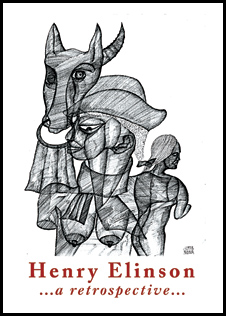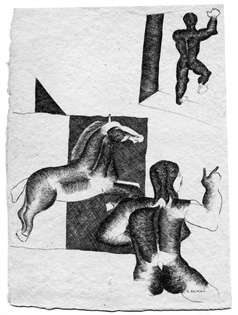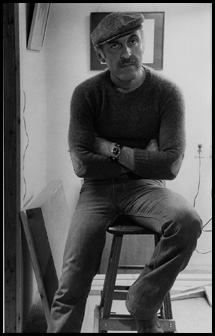Henry Elinson 1935-2010
| Go to gallery |
 |
Henry Elinson 1935-2010 …a retrospective… Opening reception: Friday, January 15, 6-9pm also open
January 23, Saturday, 3-7pm |
It is with profound sadness that I inform friends and admirers of Henry Elinson that the artist passed away on Monday, January 18, in Pacific Grove, California, after a long bout with cancer, two weeks before the closing of his retrospective at Porto Franco Art Parlor in San Francisco.
Elinson was born in 1935 in St. Petersburg, Russia. He studied philosophy and pedagogy, worked for many years as a speech therapist with mentally handicapped children, but by 1960’s had become consumed with art. He became a key member of the first unofficial, nonconformist art circles and avant-garde exhibitions of the Soviet underground and was questioned and blacklisted by the KGB. No longer able to exhibit his work, he immigrated to USA in 1973. He worked at Yale University and taught Russian for many years at the Defense Language Institute in Monterey, California. All the while, he worked relentlessly as an artist, pursuing his unique, uncompromising vision in graphic art.
Elinson’s work has been exhibited nationally and internationally at venues including Banakh Gallery (with Mikhail Chemiakin), Nakhamkin, Paule Anglim, and other galleries and museums in New York, San Francisco, Washington, Paris, Milan, Berlin, London, St. Petersburg, and Tokyo. He was awarded a Gold Medal in Art Achievement by the city of Milan, and his work is held in various public and private collections including Museum of Fine Arts, San Francisco, University Art Museum, Berkeley, Yale University Gallery, Monterey Museum of Art, Bochum Museum (Germany), Russian State Museum (St. Petersburg), and Museum of Nonconformist Art (St. Petersburg). His work has received reviews by Naum Gabo and other prominent critics and artists in national and international publications including Artforum, Artweek, and Washington Post.
As a person, Henry Elinson was as remarkable as he was an artist. We belonged to different generations – I was a son of his friends – yet despite his at times blunt manner, he had a gentle, tormented soul and a knack for effortlessly bonding with young people: beginning artists, musicians, and poets. I traveled in Paris with him in my late teens, and he would recite poetry by memory for hours as we walked, especially that of Joseph Brodsky, who was his idol. He could be abrupt, but he would never talk down or be gratuitously dismissive; instead he freely shared his spirit and listened very well. As common as such attitude might be here and now, for a Russian artist of his generation, it was more than refreshing. He was generous in praise and ruthless yet inspiring in criticism, so it is no wonder that quite a few young people sought counsel from Elinson before they ever would from their own parents. A visit with him, even when he was gravely ill, was always an unpredictable intellectual foray, and in his last days he showed his friends nothing but kindness and generosity. He is survived by his wife, Ludmila, daughter Masha, and a granddaughter. He will be missed by many, young and old, in distant corners of the world, as an artist, mentor, and a kindred spirit.
A retrospective of Elinson’s abstract and figurative pastels and works on paper will continue at Porto Franco Art Parlor until January 30.
“But the heart draws us on to the useless, the excessive,
in objects and actions. Wherever lie the unnecessary and the useless,
that is where the spirit rejoices, there is the seal of perfection.”
Fyodor Sologub
 I have known Elinson’s work for many years. His strange angular forms of people and birds that make us think of the eternal solitude of the individual, of the ineluctability of dying alone. Elinson’s works are wrapped in autumnal sadness. It is pointless to look for merriment or emotional outbursts in his work. His works are a curious mix of the psychological nakedness of Erich Maria Remarque and the sacred madness of Prague melancholic Franz Kafka. Elinson’s oeuvre belongs to only one sorrowful season of nature, a season which, however, thinking people cannot do without.
I have known Elinson’s work for many years. His strange angular forms of people and birds that make us think of the eternal solitude of the individual, of the ineluctability of dying alone. Elinson’s works are wrapped in autumnal sadness. It is pointless to look for merriment or emotional outbursts in his work. His works are a curious mix of the psychological nakedness of Erich Maria Remarque and the sacred madness of Prague melancholic Franz Kafka. Elinson’s oeuvre belongs to only one sorrowful season of nature, a season which, however, thinking people cannot do without.
In Borges’ novella The Immortal, Homer builds an absurd city, a city of insane architecture where houses have no windows or doors and stairways lead nowhere. This city is the creation of philosophers who are disenchanted with everything. Their stairways to nowhere lead Borges to the gates of the Temple of Art.
Most likely, Henry Elinson is one of the architects of this “Homerian city”. On his stairways wander sorrowful people, thinking about the unknown.
January 2010
Biography

Henry Elinson by Martha Casanave,1980
The present retrospective of art works by Henry Elinson, a native of St. Petersburg, Russia, and a former member of nonconformist art circles of the Soviet underground, includes pastels and works on paper created in the three decades since his immigration to the USA in 1973. The artist generally avoids categorization of his own style, following as he says Duke Ellington, who characterized music only as “good” or “bad”. Nevertheless, art works by Pavel Filonov, Amadeo Modigliani, Francis Bacon, post-swing jazz, and poetry by Joseph Brodsky have played an influential role in his life and his art. According to Naum Gabo, Elinson, perhaps more than many other Soviet émigré artists, has acquired his own vision and a most characteristic individual style. His work is instantly recognizable, even if unsigned or poorly reproduced, and his dedication to his artistic vision is unwavering. Here is what Elinson says about his own art:
“I don’t use forms or colors as symbols, only as elements of composition… I produce paintings, not philosophical tracts… I want the viewer to be free to discover whatever he likes. I believe in spontaneity.”
“My heart is filled with visions, dreams, and hallucinations”
Indeed, Elinson’s drawings, far from being solely formal exercises, are populated by images from his inner world, rather than the empirical reality. One exception is the work illustrating poems by Joseph Brodsky and Henry Lyman. According to W. S. Hurst (1), Elinson’s work is an orchestration of figurative and abstract forms – a very difficult and treacherous endeavor. The weightlessness of the floating lines and shapes in his drawings and pastels leads one into the unconscious world of dreams, where people, animals, and story lines draw together in unexpected ways. Despite a remarkable stylistic uniformity of Elinson’s compositions, the relationships between elements in different drawings are in constant flux. Figurative shapes and abstract shapes combine; geometric shapes and organic shapes balance. The intertwining figures, volumetric and rounded, are a frequent element – one shape is visible through another, both translucent, existing outside gravity, and exquisitely drawn. Often, there is a fantasy on the theme of a female torso. Whereas torsos known from antiquity are the surviving fragments of the vanished whole, Elinson’s torsos according to V. Kreid (2) are finished objects. They, unlike classical torsos, lack the subject that is independent of the artist and instead possess the author’s subjectivity. Elinson’s works also seem to portray the struggle between masculine and feminine elements. According to A. Rannit (3), the geometrical forms, combined with female torsos, lift sex out of its established contexts to a search for pure form. The images have a strangely primitive quality, their vacant-eyed totemic figures are either engaged in rituals or separating from each other. Leaping horses and dogs, according to D. Brookman (3), exist in uneasy relationships with the world they inhabit, and there is an eerie quality of magic, mystical detachment. Elinson’s art has been described by J. Bowlt (4) as a series of negations; it is neither autobiographical, nor philosophical, not even distinctly Russian. But what it is not reveals what it is: compositions that make us take a moment, contemplate, and look into our own inner worlds with the sense elusive recognition and uneasy wonder.
Henry Elinson is now very ill and cannot attend the present retrospective – a small step towards paying a tribute to his artistic legacy.
Paul Belasky
WORKS CITED
(1) Hurst, W. Sheldon, “Orchestrating Forms: An Introduction to Cyrillic Cabala II: Pastels by Henry Elinson”. ACC, NY, 2002.
(2) Kreid, V., “Henry Elinson”. Museum of Nonconformist Art, St. Petersburg, Russia, 2000.
(3) Rannit, A., “Eight Drawings: Henry Elinson” in New Directions in Prose and Poetry, edited by J. Laughlin. New York: A New Directions Book, 1976.
(4) Brookman, D., “Exploring Gestural Posibilities”, Artweek, v. 18:44, 1987.
(5) Bowlt, J.E., “Henry Elinson, Gallery Paule Anglim”, Artforum, 1981
BIOGRAPHY
1935 Born in Leningrad, USSR (now St. Petersburg, Russia)
1954 Studied three years at Leningrad Pedagogical Institute
1960 Studied three years at Moscow Pedagogical Institute
1960-73 Considered part of Novoye Levo (New Left) group of painters in Leningrad
1960-67 Worked at school for mentally handicapped children
1962 Participated in underground exhibition in Leningrad (disrupted by police action).
1967-73 Worked as speech therapist in psychiatric clinic in Leningrad.
1969 Exhibition in Leningrad with three architects.
1973 Emigrated from USSR to NYC; left most of his art works, taking only the few for which he could pay the departure tax.
1974 Moved to Yale University in New Haven, CT.
1976 Took position at Defense Language Institute in Monterey Peninsula, CA.
1993 Retired, continues to exhibit his art and write short stories and novels in Russian.
WORKS IN PERMANENT COLLECTIONS:
Museum of Fine Arts, San Francisco, CA
Yale University Art Gallery, New Haven, CT
Monterey Museum of Art, Monterey, CA
University Art Museum, Berkeley, CA
Bochum Museum, Germany
State Russian Museum, St. Petersburg, Russia
Zimmerly Art Museum, Rutgers University, New Brunswick, NJ
Duke University Museum of Art, Durham, NC
The Mead Art Museum, Amherst College, MA
Collection of Contemporary Art, Central Exhibition Hall, St. Petersburg, Russia
Museum of St. Petersburg History, St. Petersburg, Russia
Museum of Nonconformist Art, St. Petersburg, Russia
State Hermitage, St. Petersburg, Russia
EXHIBITIONS
2001-02 Abstract Art in Russia in the Twentieth Century, Russian Museum, St. Petersburg. 2000 Museum of Non Conformist Art, St. Petersburg, Russia 1998 Gallery Paule Anglim, San Francisco, CA 1998 The Mead Art Museum, Amherst College, MA 1996 Duke University Museum of Art, Durham, NC Gallery Paule Anglim, San Francisco, CA 1995 Morlan Gallery, Transylvania University, Lexington, KY
1994 Santa Cruz Art Museum, The Art Is … Santa Cruz, CA
1993 Gallery Paule Anglim, San Francisco, CA
1992 Dostoyevsky Museum, Art of Depression St. Petersburg, Russia
1991 Gallery Paule Anglim, San Francisco, CA
1989 University Union Gallery, California Polytechnic Institute, San Luis Obispo, CA
1987 Gallery Paule Anglim, San Francisco, CA
1987 Richard Art Center, Bay Area Drawing, Richmond, CA
1987 Clara Hatton Gallery, Sixteen Bay Area Artists
1987 Colorado State Univ., Fort Collins, CO
1985 Gallery Paule Anglim, San Francisco, CA
1981 Gallery Paule Anglim, San Francisco, CA, Beyond the Looking Glass – Other Art of Russia
1980 Stanford University, Palo Alto, CA
1980 Nakhamkin Gallery, NYC
1979 Museum of Fine Arts, San Francisco, CA
1978 Nelson Gallery University of California, Davis, CA
1978 Nakhamkin Gallery, NYC
Galerie Hardy, Paris, France
Musee du Vieux Chateau de Laval, France
Musee des Beaux-Arts de Tours, France
Musee des Beaux-Arts de Chartres, France
Kunstamt Charlottenburg, Germany
Gallerie Junger Kunstler, Germany
Ernest-Lemmer Institute, Germany
Saarland Museum, Moderna Gallerie Saarbrucken, Germany
Pratt Inst., New Art from the Soviet Union, NYC
Museum of Tokyo, Non-official Soviet Contemporary Art, Japan
1977 Monterey Peninsula Museum of Art, Monterey,CA
International Exhibition to Aid Political Prisoners Katya Granoff Galerie, Paris, France
International Exhibition to Aid Political Prisoners Parkway Focus Gallery, London, Eng.
International Exhibition of Graphique, West Berlin, Germany
New Art from the Soviet Union, Washington, DC Rowe House Gallery, Washington, DC
Banah Gallery with Mikhail Chemiakine and others, NYC
1976 Palais des Congres, Contemporary Russian Art, Paris, France
New Art from the Soviet Union, St. Louis, MO
1975 Circolo Della Galleria, Milan, Italy
Galleria II Punto, Genova, Italy
1974 Light & Motion Transmutation Art Galleries, NYC Thor Gallery, Louisville, KY
Brooklyn College Student Center, Brooklyn, NY New York University, NYC